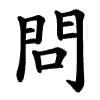問
- to ask, to inquire, to question;
Etymology
Formed as a phono-semantic compound:
口 (mouth, speech) provides the semantic element — relating to speaking.
門 (gate, door) provides the phonetic element, but also contributes symbolically: a person standing at the gate and asking.
Thus 問 originally depicted “to speak at the gate,” and by extension “to ask or inquire.”
Semantic range:
- to ask, to question (묻다, 질문하다);
- to consult, to inquire (문의하다);
- to investigate, to examine;
- by extension, to request or demand.
Usage in Korean
질문 (質問) — question, inquiry
방문 (訪問) — visit (lit. “to ask after”)
문답 (問答) — question and answer, dialogue
학문 (學問) — learning, study (lit. “study and inquiry”)
Words that derived from 問
Additional notes
In Confucian tradition, 學問 (learning through inquiry) is a central concept: true learning requires not only reading but also asking questions and seeking clarification. 問 therefore embodies the Confucian virtue of intellectual humility and the pursuit of wisdom through dialogue.
The paired notion of 問答 (dialogue) recalls the Socratic method in Western philosophy, showing a universal link between questioning and the search for truth.
- 日弓口 (ANR)
- ⿵ 門 口
